
|   |

|   |
 e-mail: leelakaverivenkat@gmail.com Music Academy's digital all Bharatanatyam Annual Festival of Dance February 14, 2022 One had no issues with the choice of dancers, though an all Bharatanatyam 15th Annual Festival of Dance in a digital form, even when sponsored by the Music Academy Chennai, makes viewing a taxing experience for even the most committed of dance watchers. In effect, it deserved to be called, not Dance Festival but a Bharatanatyam Festival. But as an inevitability during the pandemic, and perhaps even after it, one has to educate oneself to get used to this capturing of all events, in a small frame. 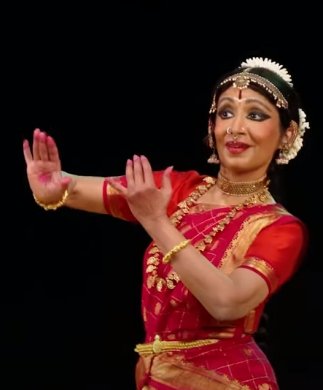 Alarmel Valli Giving a start to the festival, a portrayal of manifestations of the Devi, based on Mahalakshmi Ashtotram and other sources, was Alarmel Valli, whose unchanged physical appearance seems to have got frozen at one point of time. With music composed by Prema Ramamurthy and S. Rajeshwari, the dancer paid obeisance to the Devi as a mother figure of compassion, as embodiment of 'Vidya,' as Shakti, in manifestations as Jaganmohini, as Mahishasuramardhini, Chamundeswari and as Lakshmi and Saraswati (vellai tamarai poovil iruppaal) et al. The varnam "Saamikku Samaanam evaradi" (who can measure up to my lord?) saw the nayika dilating on the splendour of Lord Krishna in her sancharis through motifs from nature - wherein breezes swirl, trees sway, streams ripple in admiration of the splendour of the Lord of Mannargudi. The nayika unburdens her anguish in love's separation to her friend. Vasudha Ravi's vocal support and Shaktivel Muruganandam's mridangam, particularly in the charanam part, provided the right accompaniment. The best of the items pioneered on an earlier occasion, for this critic was Pushpavilasam based on a Telugu poet's work, Valli's attention first drawn to it by poet Arundati Subramaniam. This comprised the urgent voice of anguish expressed by lamenting flowers. Appealing to the devotees who ungently pluck flowers for the pooja and for women to adorn their hair, and for other purposes of decoration, or painfully crush the flowers to provide 'attar' (perfume), seem to merit only being cruelly swept away when withered. Does anyone ever think of what one is doing to nature's beautiful, docile creatures who love to play and laugh on the lap of their mother, the Earth, who perfume breezes and provide honey for many creatures? The anguished devotee on hearing the lament says that all he can contribute is a poem, which he humbly presents - a poem voicing their distress. The music by Rajkumar Bharati with suggestions from Prema Ramamurthy and Savita Narasimhan, along with Valli's impassioned dance made for a fine combination. 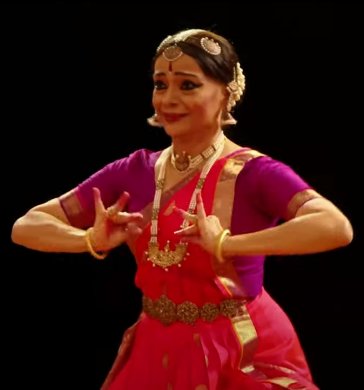 Malavika Sarukkai The other senior inevitable selection for the Music Academy festival, Malavika Sarukkai, began with Adi Shankara's hymn "Prabhu prananatham" with the score composed by late Sitarama Sharma. The description of Shiva "gale runda mala" with the Maha Kala Kalam and Jatha Jootam was embellished with some bristling jatis "tarijham taritajham..." Gangavataram, with the Ganga Stotram, with the Bhageerathi and Alakananda, two rivers with different moods, joining (always a favourite theme with Malavika) with the tabla percussion in-between in its musical tones, making for a sensuous Bhagirathi's flow, with wonderment overflowing at the joining of the two rivers at Devaprayag ('Najane tava mahima') saw a very involved dancer. Marking the monsoon season came a scene from Andal's Nachiyar Tirumozhi with young girls playing, building sand castles near the sea, when Krishna with his lotus eyes appears and the girls are thrown into a confusion of emotions - shyness, restraint, romance - all surging feelings which, like the sand castles, can be easily crushed. From here the scene shifts to a grown up Andal with her love for 'Perumal'. The purely devotional mood takes over and iconic images come into play in the dance - the lord standing as Vishnu, in the lying down posture as Ranganatha and as Narasimha in the seated posture. The dancing clouds rejoice with the lord, with the final homage to the Tirupati lord with the 'Venkataachalapathe tava suprabhatam' recitation ringing in the ears. Malavika ended with Balamurali's tillana in Brindavani, after which the fitting end was Vande Mataram at a point when our country has registered its 75th year of Independence. 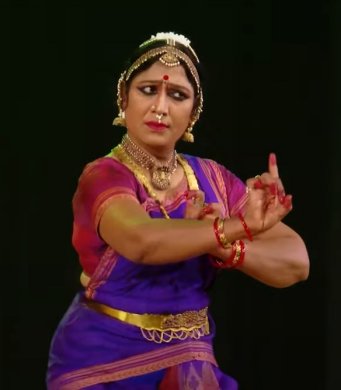 Narthaki Nataraj It is the heartland of ancient Bharatanatyam legacy under Guru Kittappa Pillai that Narthaki Nataraj was trained in, after years of Gurukulavasam under the Tanjavur Nattuvanar. Narthaki's invocation was with the fifth Kavutvam from the Panchamukhi viz the 'Tanjai Nalwar's Chandikeswara Kavutvam, traditionally presented after rendering the 'Sertharan Tirupallaandu' sung in viruttam. The legend behind it is of herdsman and ardent Siva bhakta Vicharacharamu, who fashions a lingam out of the sand, offering daily milk abhishekam through his cows. Enraged when his own father kicks and destroys the Shivalinga, the bhakta attacks the father's leg with an axe. This depth of devotion pleased the lord, earning the devotee a permanent place near Shiva in the temple prakaram, as one of the 64 Nayanmars. Shiva also cures the father's injured leg. The belief among regular temple goers, that Chandikeswara's permission has to be taken before accepting prasad in a Shiva temple, results in the symbolic action of devotees clicking their fingers before his idol. The dancer went on to the Tana Varnam "Sarasijanabha" in Kamboji, in khandajati atta talam, portraying the lord with the lotus navel reclining on the sea couch, both Prahalada and Gajendra having sought refuge at his divine feet. While Narthaki's expressional dance has always been of high standard, the quality of energy in executing the Kittappa Pillai jatis (while rhythmically very correct in the unmatched foot contact rhythm with the sollu, both amazingly coming together on the sama), has lessened with time. Narthaki's next item was a surprise from a dancer who rarely strays beyond the Tamil/Telugu compositions, based as it was on poet Nazrul Islam's Bengali Geet, eulogising the creator of sky and ocean (who is Kalaimagal, Tirumagal, Bhagavati) who is Maha Vidya Gayatri of the Rig Veda, and the magical One who manifests as Nirguna Paramatma. The worshipper entreats and seeks liberation from sins. Attention paid to the rounded Bengali pronunciation was interesting to hear! The dancer followed this with a Kavadichindu "Aarumukhane, Vadivelane Kalyanam Seyyavillai". "How dare you shamelessly address an unmarried girl? Have you no sense!" the young nayika questions Muruga's temerity. The tillana in Kamas by Madurai Chokkanathar was followed by a special Mangalam by Tiruvottiyur Thotikalai Subrahmanyam describing Shiva as "Kaal maari aadiya Gangai anindavar". 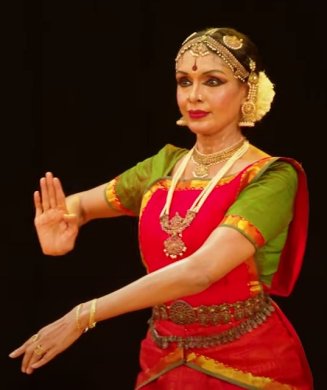 Priyadarsini Govind Priyadarsini Govind began with a Panchajati Alarippu composed by G.Vijayaraghavan. It was clear from the Dandayudapani Pillai varnam "Mogamahinen" in Karaharapriya which she presented, that the dancer has got back her old form. After the varied interpretation of complaints about Manmatha's thwarting her, in the charanam line, the mood changes as the nayika challenges "Yarukkagilum bhayama, idu ragasiyama?"(What is wrong in loving, and this is after all no secret, she says). The dancer's abhinaya has always been her strong point and through a string of compositions, Priyadarsini basked in her expressional elan - starting with the item on Ravana looking at each of his ten heads, reflecting on the sad aftermath of lust for Sita - sad, downcast, complaining, silent, open- mouthed trembling, weeping, - each looking at Sita, all fatigued with unrequited passion and lust. 'Alas! What was I and what have I been reduced to!" he laments in self pity, "Vishannam Maamuda, Sita durvinayena". Spurred by music composed by Rajkumar Bharati, Priyadarsini's projection was evocative. This was followed by a Javali in Kapi, with the nayika being berated for getting involved with the two-faced man, despite all her earlier warnings. The best of the evening was Lament of Yashodhara after Siddartha leaves in the stealth of night without a word of farewell to the wife, who has just had a young son. Why this secrecy? She describes herself as the creeper without support, with no light or darkness. "Beloved, who resides in me all the time, why did you not wake me up?" Again strung to music by Rajkumar Bharati, the poignancy of the situation was soulfully brought out, "Kopa karanamemo? Lepanaina." With Vasudha Ravi for vocal support (Embar Kannan doing the singing for the Ravana item), Jayashree Ramanathan's nattuvangam, and with Shaktivel Muruganandam on mridangam, Shikhamani on the violin and Sruti Sagar providing flute support, the wings were well equipped. 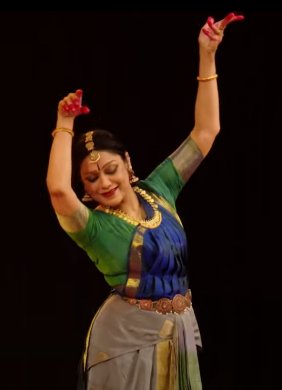 Rama Vaidyanathan Another constant for Music Academy festivals, dancer Rama Vaidyanathan rang in the finale for the festival. She began with a Sabdam composed by Tanjavur Arunachalam Pillai. ("Tillai Ambalam tannilai nadam seydidum Natarajan, Sakhi, ingu taan varuvarodi? Swapnattil kanda deivam, sonda deivam aavano?") "Will that lord who danced in Tillai Ambalam come here? Will the lord I saw in my dream, become my own lord?" asks the young maiden. The varnam in Anandabhairavi and atta talam, a composition of Shyama Shastri, has the nayika expressing her love for Varadarajaswamy of Kanchipuram. "I cannot take his name. Please fetch him," she pleads with the sakhi, "Saami rammanave". She blames Kama Deva (Ve Maaru, for his banas) for her love stricken fate and challenges him that every flower bedecked arrow Manmatha attacks her with, will be burnt to ashes by the fire and passion of her love. Rama captures in detail the Garuda Sevai, an important part of the festivities in the Varadaraja Perumal temple in Kanchipuram. With Sumod Sreedharan's jati punctuations, the varnam had its appeal. While one cannot help feeling that singer Sudha Raghuraman's solo concert style of singing with its gamakas is a bit ornamented, unlike the conventional margam support in a varnam where the lines are kept simple, Sudha and Rama have formed an understanding which works well. Besides, the singer's creativity, like the contribution for the Abhang for which her score in Sohini, along with excellent Marathi pronunciation made for a moving item, points to this vocalist's worth in a dance programme. Rama was asked by Ananda Shankar Jayant to interpret an Annamacharya Padam, "Sathi ninnu galichenu" addressing Venkateshwara, that in the game of love and passion, Alamelumanga triumphs over him. Even Manmatha loses the battle with words which try to overpower, but Alamelumanga wins with her devotion, without words. Rama's interpretation was of the words emerging after being witness to a quarrel between the couple, wherein his indifference pitted against her loving attitude, becomes the loser. A more direct interpretation could be of love itself being invariably the victor, no matter what the occasion. The raga Karnaranjani, in which the Padam has been composed, has an appeal all its own. Rama's recital concluded with a soulful "Vithala namachi shaalabharini" Abhang in raga Sohini. 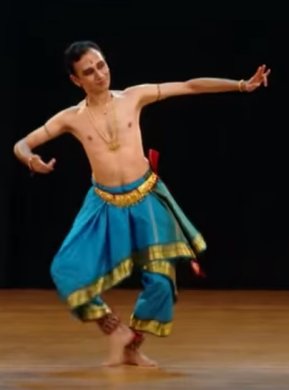 Praveen Kumar The three male dancers presented in the festival, all with excellent dance profiles, makes one wonder as to why the prejudice against the male dancer persisted for so long - particularly since, according to the highest tenets of Indian art aesthetics, gender, and other considerations of the dancer or actor are of no consideration - for it is the performed aspect which has to evoke 'rasa'. Praveen Kumar, the senior most among the male dancers presented, trained under stalwarts like Narmada and for years now with Prof C.V. Chandrasekhar, has earned a name for his undiluted classical proficiency. Beginning with a sloka set to Saranga 'Aditya hridayam' paid homage to the dispeller of darkness, the Sun, who represents the conscious mind, whose rise in the east in the early hours, ushers in daybreak enabling the lotus to bloom, drenching the earth with light, till it sets in the west. After rendering a Tanjore Quartet jatiswaram in Ragamalika and Misrachapu, came the varnam "Saami ninne kori naanura"- a traditional quintessential Ragamalika centrepiece, given an original flavour in the interpretation by the dancer. Imagining the nayika's love for Brihadeeswara as a process involving the heroine from her childhood to maturity, Praveen showed the young girl involved with a Shiva lingam. This sense of possession with an abstract object, changes in the line "Sada neevu nannenu kora" to a budding romantic attachment to the anthropomorphic form of Shiva, evoking, she feels, response from the lord. In "Bira nannenu kora Sri Jagadheeshwara" she has reached a stage of offering her love to the lord and she is overwhelmed by the ocean of longing (Biraga sagara). In the charanam, the nayika confidently asserts that she is the most fitting mate for Brihadeeswara. The jati punctuations added an extra quality of emphasis, with percussionist Lingaraju, who in the soft and more emphatic touches seemed to go along with the dancer, making the mridangam express mood along with rhythm. The idea of doing away with any percussive accompaniment for the Ashtapadi "Kshanam Madhunaam Narayanam" set to Dvijavanti was an excellent idea, for it preserved the quietude of the moment when Krishna who, repentant about his earlier mood is offering himself to Radhika, waiting for consummation of love - "Anugatam anusara Radhike kisalaya shayana talekuru kamini, charana nalina vinivesham". Percussion, no matter how soft, could have punctured the silence of the moment. In a transfer to the completely devotional and penitent mood of a devotee who, during his younger days forgot about spirituality or charity for the less fortunate poor who needed help, the Kanaka Dasa bhajan "Chennakeshava naan nambalilla, maimaratenalla" came as a penultimate presentation, and the only item sung by singer Srivatsa. Swati Tirunal's Dhanashree Tillana marked the conclusion. Comprising Praveen's well set team of musicians, the recordings with the dancer himself doing the nattuvangam, had vocalist Raghuram, mridangist Lingaraju, flautist Mahesh Swamy, and Gopal Venkataraman on the veena. 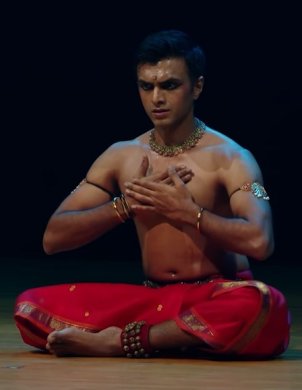 Parshwanath Upadhye Not in the senior group, Parshwanath Upadhye has turned into one of the most promising dancers. The gravitas in his dance with his training under Sudharani Raghupathy, apart from toning down the earlier gymnastic excesses (given his supple body trained in Yoga), along with an enhanced ability to internalise emotion, have made him into a more sensitive artist. Beginning with a prayer to Sri Chamundeshwari in Bilahari, the dancer's choice of Pada Varnam "Pancha vaktram dashabhujam namami, Sri Rama dootam" revolving round Hanuman's feats of crossing the ocean and fetching the mountain for the plants to cure wounded Lakshmana, and destroying the Rakshasas, looked like the ideal narrative to pin poses knotting up the body in the most convoluted postures - particularly while portraying child Hanuman "Anjana sutam Rudraamshajam, Sugriva vilita bhanum,..." where a lot of pranks and leaps could have found expression. But not one instance could one spot of departing from the traditional Bharatanatyam prescribed attitudes. With Srikanth Gopalakrishnan's vocal support, along with the highly involved rendition, it was a presentation of dignity and restraint - very evocative. It was very intelligent of the dancer to spot a lyric like Kshetrayya's "Choodare" where an entire composition makes no reference to the gender of the person passing the remarks - accepted in convention, as attributed to gossiping women exchanging biting comments on the woman who is seen jauntily strutting without shame, seeking her beloved, while being married into a well known prosperous family. The dancer treated this well known lyric from a male perspective, portraying a roadside Romeo known for his snide comments on women. While very convincingly presented, I was more struck by the close look at sahitya, detecting that the words could as well be attributed to a male. Parshwanath concluded with a prized tillana composition by Venkatagiri Appa in Behag, set to adi talam. The performance pointed to an evolving artist. 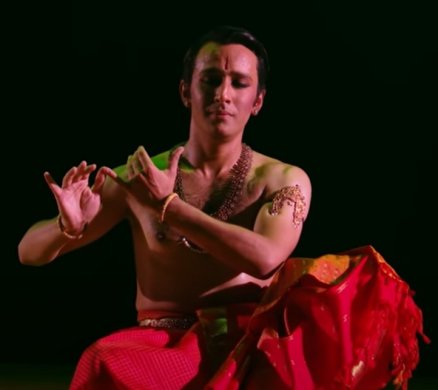 Christopher Gurusamy Attracting the attention of organisers lately is Christopher Gurusamy, whose wing support for this performance comprised nattuvangam by Sudarshini Iyer, vocal support by Murali Parthasarathy, mridangam by Shivaprasad with Sai Rakshak on violin. After rendering the Natesa Kavutvam as a curtain raiser, revealing at once the dancer's excellent araimandi (balanced on toes with the heel not touching the ground) and light footed jumps, came the centrepiece, the Kamboji varnam "Nadanai azhaithu va sakhiye" (for which the main inspiration - with the Vazhuvoor flavour - came according to the dancer's statement, from listening to the music cassette which had Swamimalai Rajaratnam's vocal support with jatis by Arjunan Poovendran). It is heartening to see the dancer's evolving expressional involvement, portraying the nayika's anguish of separation in love, with a sanchari admonishing the peacock (very appropriate when the object of love is Murugan) urged to convey a message of love, that there was nothing to spread wings and dance about, while the nayika herself was in the depths of despair. The dance sang the praises of the six faced lord who gave the message of Nadopadesam, lighting up the world with knowledge. The leg extensions and the sarukkal and leaps while executing nritta to solfa passages and jatis had a geometrical precision. It was evident from the presentation that Christopher has benefited from not just the Kalakshetra and Leela Samson training, but also from Bragha Bessel who is honing his abhinaya talent. Aided by bhav filled singing, the dancer rendered the Kshetrayya Padam "Rama Rama Prana Sakhi" wondering as to how Rama could have coped with the anguish of separation from his beloved Sita. Under the guidance of Prof. Raghuraman, the extract from Bharati's Kuyil Paatu choreographed by Bragha, depicted three friends wondering what would be left in their lives without the presence of their bosom companion Krishna, finally arriving at the conclusion that since He resided within them, there would never be any real separation. The finale was marked by a tillana of Oothukadu Venkatasubbaiyer in Suruti. 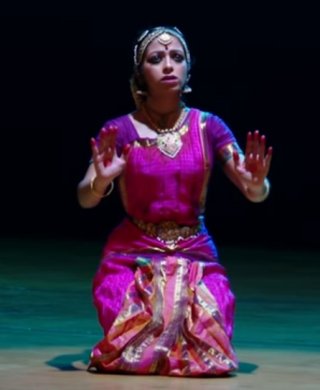 Apoorva Jayaraman For this critic, Apoorva Jayaraman (now a student of Priyadarsini Govind after being trained under Supriya Sreedharan and Padmini Ravi) gave one of the most well designed concerts of the festival, with the right blend of classicism and an untinged contemporary sensibility. She began with the Nasa Suktam, the 10th mandala of the Rig Veda, the Hymn of Creation, posing the primordial question Whence this Creation? When there was neither existence nor non existence, nor the cosmic waters, how and when did creation start with fertility, and what prompted the seed of the Feminine Principle and that of the Masculine Principle to get united - thereby starting the process of Creation? Does the One above know? Perhaps even He does not. With music composed by Rajkumar Bharati, the inevitable refuge for all in search of a contemporary musical tone, the dancer's visualisation with constantly fluttering Alapadma hands, had the right element of being caught in a quagmire, where one does not know where to start - for there is no beginning or ending. Set with Dandayudapani jatis, the varnam in Ragamalika "Swamiyai azhaittodi vaa" was rendered with panache, with the sancharis showing the vahana and sons of Shiva being coaxed to act as messengers of love to the lord. The dancer made most of each line in the sahitya set to a different raga. With birds, bees, flowers involved in the breezes of Spring with romance ripe in the air (in raga Vasanta), with the bits of freewheeling taanam in the music in the line "Sada ninaivu kondu meyal meerude" in Shankarabharanam visualising the lord as Nataraja, and the Kanada and Bhairavi lines as the lord dances with Nandi providing mridangam support with Narada singing, every line was danced with involved joy, making this centrepiece very absorbing. The pure abhinaya part was also riveting with an item based on a short story by Pudumai Pithan "Swapna Vimochanam" based on the Ahalya episode in the Ramayana. Ahalya resurrected by Lord Rama, worships the lord as the very acme of Dharma till she hears about Sita's Agni Pariksha. Confused and distressed that while she, with all her guilt in having knowingly committed adultery, was forgiven while a person as chaste and blameless as Sita was put to such a cruel test by the same Rama, she asks, "What is Dharma?" Unable to find an answer she withdraws from life becoming like a stone once again - this time voluntarily. Again the music composer was Rajkumar Bharati. Apoorva concluded with Nritta Lahiri and Kavi Subramanya Bharati's Ode to Motherland, choreographed by Priyadarsini Govind. Altogether a very thoughtfully planned recital. 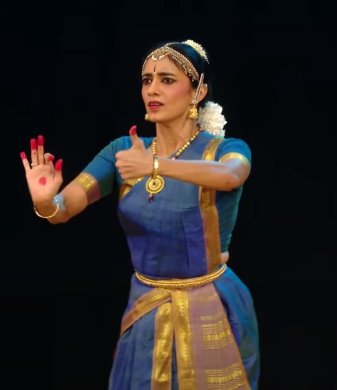 Lakshmi Parthasarathy Athreya Performing during the afternoon of a packed day of programmes, very trying on the concentration and eyes of the viewer was Lakshmi Parthasarathy Athreya, her entire suite choreographed by her Guru Chitra Visweswaran. After a breezy Anjali start with an Oothukadu Venkatasubbaiyer kriti in Gambhiranattai set to adi talam tisra nadai came Ananda Ganapatim bhavaye, the Kamba Ramayanam "Anjaneya Raghurama dootam" in Kamboji, portraying the narrative of Anjaneya's lifting of the mountain with the plants to save Lakshmana to rouse him from comatose condition, and setting Lanka on fire with the flame from his burning tail. As a choice for a female dancer, this varnam with the high vaulting movements of the monkey, usually preferred by male dancers, showed a certain unselfconsciousness - devoid of the need to look pretty, an important aspect of an evolved dancing mind - aside from the fact that the light footed Vazhuvoor tradition, unlike the emphatic foot stomping Pandanallur, (which Chitra Visweswaran has carried to a fine point) makes of Hanuman a graceful hero. The post varnam abhinaya part saw the dancer present Muthu Tandavar's "Teruvil Vaaraano" in Kamas which in the rendition one felt, could have had more intensity in bringing out the strength of the wishful thinking of the nayika, followed by a composition on Meera's longing to unite with the lord in "Pyare darshan deeje, Tuma bina rahaa na jay" Through several lives as fish, elephant, deer and finally as human, Meera's desires to become one with Krishna, remained the same. And finally discovering him within her, she realises her goal. The music in raga Bhairav was composed by Visweswaran, with Chitra Visweswaran's choreography. Madurai N. Krishnan's tillana composition on Rajarajeswar signalled the end. 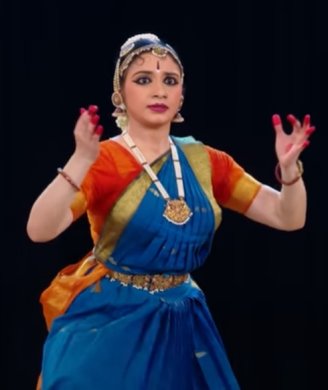 Meera Sreenarayanan One can still recollect how some years ago, an absolutely enraptured audience gave a standing ovation to dancer Meera Sreenarayanan, presented for the first time in one of the morning performances for junior dancers. Since then one has taken her talents for granted. Starting with a jatiswaram of Adyar K. Lakshman came the Lalgudi Jayaraman's Charukesi varnam "Innum en manam ariyadavarpol" after which the dancer went on to another marathon number viz the Swarajati in Bhairavi by Shyama Shastri on Kanchi Kamakshi. This composition,which even in the rendition of the song is endowed with a slow savoured quality, was particularly suited to the quality of stillness so much a part of Meera's dance- where one gets a feeling of moments held in eternity. And from her guru Indira Kadambi, I learn that this composition was entirely taught online. The training under Indira Kadambi has invested Meera's abhinaya skills with enhanced power of communication. The singing as well as nattuvangam for the varnam and for the Ashtapadi "Chandana charchita" describing Krishna sporting with the Gopis, (again learnt online) was by Bijeesh Krishnan with Charudutt providing mridangam support. For the swarajati in Bhairavi, Saraswati Slokam, and Jathiswaram, the singer was T.V.Ramprasadh, Indira Kadambi's husband. The dancer ended with a sloka 'Jaya Jagadeeshwari' on Saraswati, set to music by T.V.Ramprasadh and choreographed by Indira Kadambi. 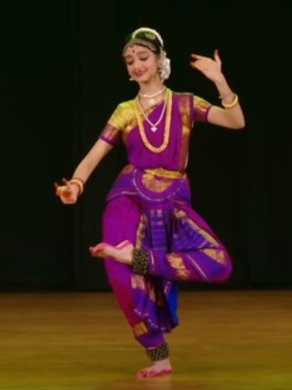 Mahati Kannan The youngest dancer of the festival, a well known performer for audiences in the South, projected in the morning session was Mahati Kannan, niece and disciple of Padma Subrahmanyam, equipped with integrated training in dance and music, with associated knowledge in the Sastras on literature, painting and sculpture. She began with a Kavutvam her guru resurrected from a 300 year old manuscript, on Ganapati. Dandayudapani Pillai's jatiswaram in Hamsanandi, in roopaka talam, became for Padma, an occasion for choreographing movements suiting the Hamsa+saha, the bird which can separate ksheera from water, and is associated with great saints, and the movement composition had karanas based on the hamsa's movements, making this an unusual jatiswaram, with Mahati capturing them as to the manner born. The varnam in Valaji, a composition of Kunakkudi Venkataramaiyer choreographed by Mahati's guru, wherein the homage to Sri Gopala comprises special emphasis on the Krishna Tulabharam episode, brought out the divinity of the tulasi plant, with the danced narrative also portraying his other childhood pranks and feats, the feature which stood out in Mahati's dance, being her effortless, almost boneless ease in holding the most involved postures. Padma Subrahmanyam's creation of a Gatibheda Prabandham in raga Kedaram on Shiva and Kedarnath, had in reverse order, the lyrics composed by Sri Ramanan in the same metre as the music - another unusual item. Dayanand Saraswati's composition in Bageshri ragam in tisragati, adi talam - Madura Madhura Meenakshi Madhurapuri nilaye Amba, the Goddess who is Vaakvilasini, Matangi, Marakatangi, comprised another item. With Padma Subrahmanyam as guru, mother Gayatri Kannan providing vocal support and father Kannan Balakrishnan on the mridangam - Sruti Sagar on flute and Nagai P. Sriram on the mridangam were the only non family members in the troupe.  Writing on the dance scene for the last forty years, Leela Venkataraman's incisive comments on performances of all dance forms, participation in dance discussions both in India and abroad, and as a regular contributor to Hindu Friday Review, journals like Sruti and Nartanam, makes her voice respected for its balanced critiquing. She is the author of several books like Indian Classical dance: Tradition in Transition, Classical Dance in India and Indian Classical dance: The Renaissance and Beyond. Post your comments Pl provide your name and email id along with your comment. All appropriate comments posted with name and email id in the blog will also be featured in the site. |